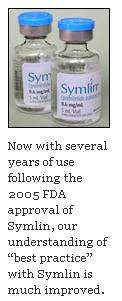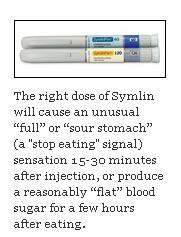Pramlintide Applied: Practical Tips for Getting Symlin to Work Right
.JPG)
It took more than 80 years after the discovery in insulin for another medical treatment for type 1 diabetes to finally come along. You would think that everyone with type 1 would have jumped on the Symlin bandwagon, but that just hasn’t happened. Fewer than 5% of all type 1s in the US are using Symlin.
Why? Several reasons. Insurance coverage is not easy to come by (although it has improved significantly since Symlin was approved in 2005). Nausea (albeit mild and short-term) is a common side effect. It requires extra injections. And many physicians are not yet “comfortable” prescribing or recommending it. But these are the kind of things that type 1s are used to dealing with and can usually be overcome with a bit of persistence.
Having taken Symlin myself for several years and having guided dozens of clients to make the transition, I believe that the biggest barrier is the complexity involved in getting it to work right. Which is a shame, because when Symlin works right, it can produce some very nice benefits.
 a brief background
a brief background
Symlin is equivalent to amylin, which is normally secreted along with insulin by the beta cells of the pancreas. It acts to do the following:
-
Slow the rate of emptying of the stomach’s contents into the small intestine for absorption (this is called gastric emptying)
-
Blunt the secretion of glucagon by the pancreas (ironically, the pancreas of people with type 1 diabetes secretes excess amounts of the blood glucose-raising glucagon just after meals)
-
Enhance satiety (feeling of fullness) and decrease appetite
By slowing digestion, limiting food intake, and keeping the body from raising blood glucose levels on its own during the period immediately following meals, Symlin minimizes the blood glucose rise that occurs after meals in most people with diabetes. Postprandial (after-meal) spikes, as these are called, can influence one’s energy level, mind function, emotions and physical abilities. There is also growing evidence that these spikes can raise A1c levels and contribute to the development of long-term complications.
Symlin can also be a valuable weight loss tool: Users of Symlin lose an average of 6.6 pounds over the first six months of use, mainly by consuming smaller portions at meals and snacking less often. Given that many people with type 1 diabetes have difficulty controlling their appetite (likely due to lack of the amylin hormone), adding Symlin to one’s treatment has obvious lifestyle benefits.
Symlin is taken by injection (either syringe or pen) in a fixed dose before meals. The FDA has approved Symlin for use by adults with type 1 or type 2 diabetes who take rapid-acting insulin at meals. Although not yet approved for use in children, several studies have shown that Symlin is safe and effective when used in a supervised manner by adolescents. And, although it isn't yet approved for patients with type 2 diabetes to use before meals instead of insulin, Symlin may be approved for this use in the future.
 complicating factors
complicating factors
Unlike insulin, which works in proportion to the amount given, Symlin is more like an “on/off” switch. The dose either works, or it doesn’t. There is no “gray area.” You have to get to a minimal dose before it has any effect at all. But taking much more than the minimal effective dose can cause pronounced side effects. So determining the right dose of Symlin is important.
Because Symlin blunts digestion, appetite, and glucagon production at meal times, blood glucose levels can be affected significantly. Blood sugars will tend to rise slower and later than usual, and the total rise may be less than expected. As a result, insulin doses and timing will require some adjustment - so if you go on Symlin, get ready to experiment with your healthcare team!
Symlin also increases the risk for hypoglycemia if proper insulin adjustments are not made. If hypoglycemia does occur, treating it can be a challenge. Attempts to treat hypoglycemia with traditional means may take a very long time to have any effect. Special precautions to prevent and properly treat hypoglycemia will need to be taken. The drug is also not recommended for use in those with hypoglycemia unawareness or gastroparesis (delayed emptying of the stomach).
strategies for symlin success
As those of us with type 1 diabetes have proven over the years, where there’s a will, there’s a way. And there are several ways to make Symlin work safely and effectively.
-
Start on a small scale. To figure out the right dose of Symlin and accompanying insulin adjustments, start out using Symlin at one meal only, such as breakfast. Once doses and adjustments are determined at that particular meal, apply the same strategies at your other meals. Remember, the dose of Symlin does not vary from meal to meal; the same dose is taken regardless of what is eaten. And the insulin dose adjustment and timing should work consistently whenever Symlin is taken.
-
Determine the Symlin dose. Begin with the lowest dose of Symlin (15 mcg by pen, 2-3 units by syringe) and stay with it for three days. Increase in 15 mcg (2-3 unit) increments until a therapeutic dose is reached. The right dose of Symlin will cause an unusual “full” or “sour stomach” sensation 15-30 minutes after injection, or produce a reasonably “flat” blood sugar for a few hours after eating. If neither of these occur, the dose of Symlin needs to be increased. Get in the habit of checking your blood sugar an hour after eating (or check your trends on a continuous glucose monitor) while figuring out your Symlin dose.
-
Take Symlin before and insulin after. Take Symlin 5-10 minutes before your meal, and take your insulin 5-10 minutes after your meal. This will help ensure that the Symlin is working at the right time, and the insulin will not peak too soon and cause post-meal hypoglycemia. If you start to see a drop in blood sugar soon after eating followed by a significant blood sugar rise a few hours later, delay the insulin further or consider switching to regular insulin. If you use a pump, employ the square, extended or combo bolus feature to deliver the insulin over a 1-2 hour period.
-
Reduce the insulin dose modestly. When starting to use Symlin, reduce the usual dose of mealtime insulin by about 25%. Symlin’s package insert recommends a 50% reduction, but in clinical practice, we have seen that mealtime insulin needs only a reduction of an average of 10-20% when Symlin is used. A 25% reduction is a safe and reasonable starting point. If you use an insulin-to-carb ratio, the following chart can help:
I:C Ratio without Symlin I:C Ratio with Symlin 1u:5g 1u:6g 1u:6g 1u:8g 1u:7g 1u:9g 1u:8g 1u:10g 1u:10g 1u:13g 1u:12g 1u:15g 1u:15g 1u:19g 1u:18g 1u:23g 1u:20g 1u:25g 1u:22g 1u:28g 1u:25g 1u:31g 1u:30g 1u:38g 1u:35g 1u:44g 1u:40g 1u:50g -
Fine-Tune. Once you have settled on the right dose of Symlin, you can fine-tune both the timing and amount of mealtime insulin. The amount of the insulin adjustment should be based on your blood sugar level prior to the next meal: Frequent above-target readings means that your dosage at the previous meal needs to be increased. Below-target readings mean that an insulin dosage reduction is in order.
The timing of the dose depends on the blood sugar 1-2 hours after the meal. If the blood sugar drops soon after the meal and then rises over the next couple of hours, the insulin needs to be delayed further or (if using a pump) extended over a longer period of time. If the blood sugar is peaking too high soon after the meal and then dropping before the next meal, the insulin needs to be taken earlier or (if using a pump) the extended delivery duration needs to be shortened; a dual/combination bolus could also be used. -
Changes over time. The Symlin dose may need to be increased with prolonged use. After several months or years of use, many people develop a tolerance to Symlin, and the dose may need to be taken up slightly in order to achieve the same results.
-
Manage the lows. To prevent Symlin-induced low blood sugars, do not take Symlin if you plan to have a slow-digesting meal (such as pasta, dairy, beans, or high-fat restaurant food), if you plan to exercise soon after the meal, or if your blood sugar is low (or borderline low) going into the meal. If hypoglycemia occurs after eating, the usual treatments may take too long to reach your bloodstream. Instead, glucose tablets or gel can be placed below the tongue in order to achieve sublingual absorption, or a glucagon injection may be required.
If all this seems like a ton of work, rest assured, it really isn’t. It’s just a matter of doing some extra testing and adjusting during the first couple of weeks of Symlin use. And once you have it down, you’re pretty much set. Of course, if it all just confuses you, feel free to give me a call. We can work together by phone and internet to get it all figured out.
Remember, using Symlin is like using a computer. When it works the way it should, life couldn’t be better. When it’s giving you problems, life couldn’t be worse. (No, I’m not going to get into trouble with Mac vs. PC comparisons, but you get the idea.) If you’re going to give Symlin a try, go about it the right way. Think things through and you’ll save yourself a great deal of frustration.







